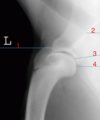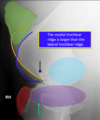Anatomy Quiz Flashcards
(174 cards)
Name the view seen here

Lateromedial view of Equne hoof
Name the view seen here

Dorsopalmar View of Equine Hoof
Name the Structure

First phalanx (long pastern)
Name the Joint

Proximal interphalangeal joint (pastern joint)
Name the Structure

Second Phalanx (short pastern)
Name the Joint

Distal interphalangeal Joint (coffin joint)
Name the Structure

Third Phalanx (coffin bone)
Name the Structure

Navicular Bone
Identify the structure indicated by the arrow

Extensor process of P3
Identify the structure indicated by the arrow

common digital extensor
Identify the structure indicated by the arrow

impar ligament
Identify the structure indicated by the arrow

Digital cushion
Identify the structure indicated by the arrow

Deep digital flexor
Identify the structure indicated by the arrow

straight sesmoidean ligament
Identify the structure indicated by the arrow

insertion of oblique sesmoidean ligament
which view is good for assessing solr margins of P3 and the navicular bone
Dorsal proximal to palmar distal (upright pedal)

Identify the structure indicated by the arrow

navicular bone
Identify the structure indicated by the arrow

wings of the coffin bone
Identify the structure indicated by the arrow

solar margin
Identify the structure indicated by the arrow

semilunar canal
Identify the structure indicated by the arrow (light blue lines)

vascular channels
Identify the structure indicated by the yellow dotted line

dirt in the white line on bottom of the hoof
name the structure indicated by the orange line

crena margins of solearis
WTF is the crena margins solearis
smooth round concavity of the distal phalanx solar margin (more prominent in hindlimb)
































































































































